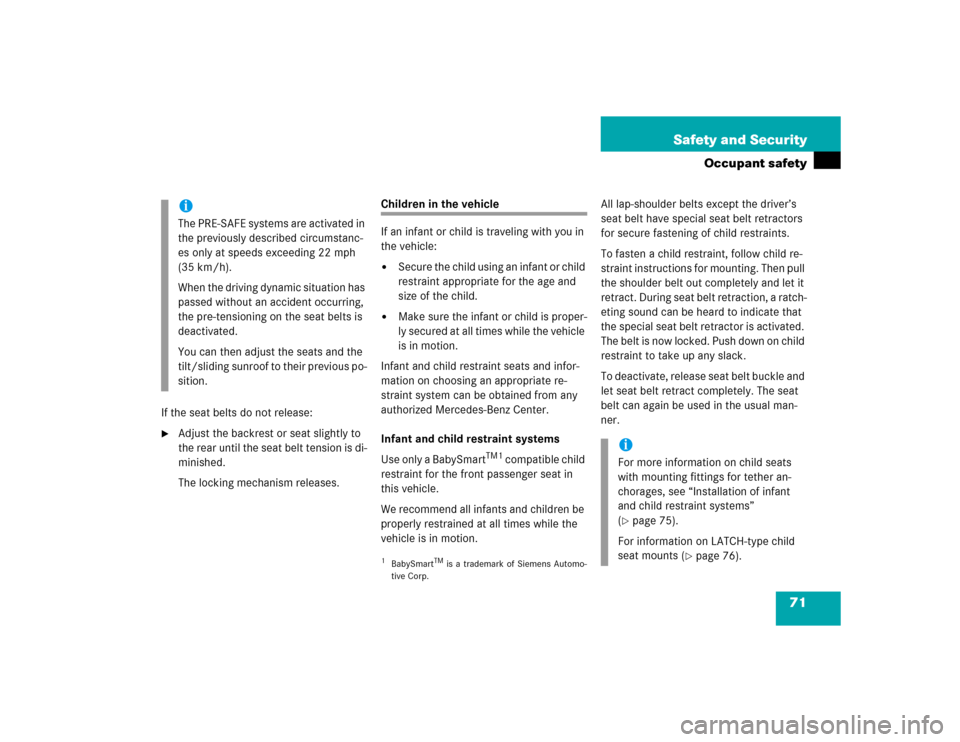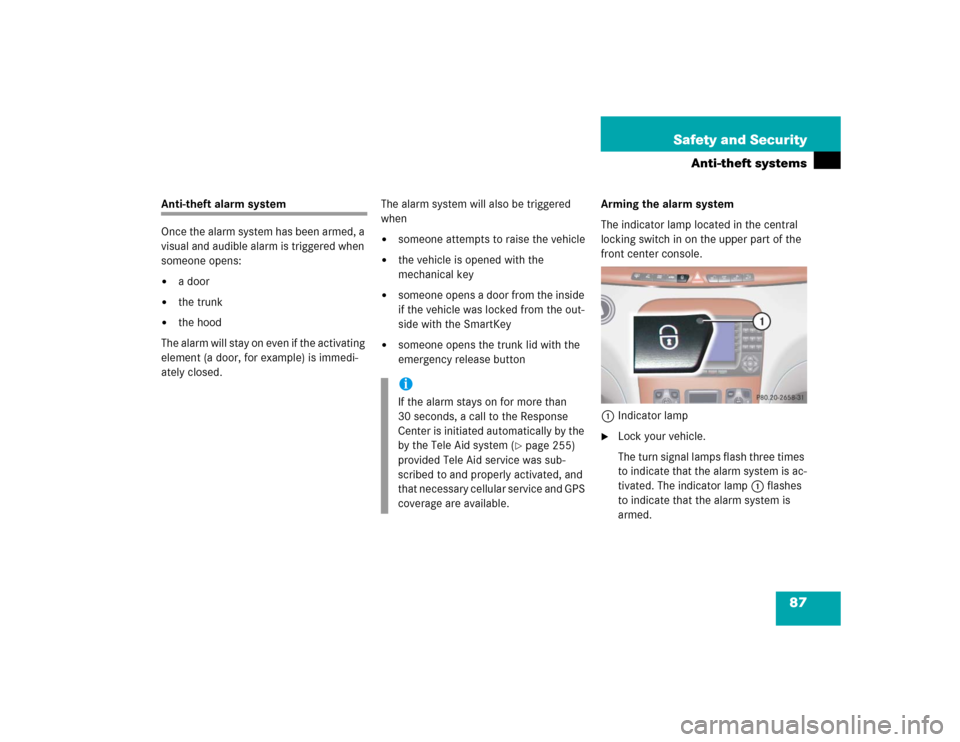Page 73 of 474

71 Safety and Security
Occupant safety
If the seat belts do not release:�
Adjust the backrest or seat slightly to
the rear until the seat belt tension is di-
minished.
The locking mechanism releases.
Children in the vehicle
If an infant or child is traveling with you in
the vehicle:�
Secure the child using an infant or child
restraint appropriate for the age and
size of the child.
�
Make sure the infant or child is proper-
ly secured at all times while the vehicle
is in motion.
Infant and child restraint seats and infor-
mation on choosing an appropriate re-
straint system can be obtained from any
authorized Mercedes-Benz Center.
Infant and child restraint systems
Use only a BabySmart
TM1
compatible child
restraint for the front passenger seat in
this vehicle.
We recommend all infants and children be
properly restrained at all times while the
vehicle is in motion.All lap-shoulder belts except the driver’s
seat belt have special seat belt retractors
for secure fastening of child restraints.
To fasten a child restraint, follow child re-
straint instructions for mounting. Then pull
the shoulder belt out completely and let it
retract. During seat belt retraction, a ratch-
eting sound can be heard to indicate that
the special seat belt retractor is activated.
The belt is now locked. Push down on child
restraint to take up any slack.
To deactivate, release seat belt buckle and
let seat belt retract completely. The seat
belt can again be used in the usual man-
ner.
iThe PRE-SAFE systems are activated in
the previously described circumstanc-
es only at speeds exceeding 22 mph
(35 km/h).
When the driving dynamic situation has
passed without an accident occurring,
the pre-tensioning on the seat belts is
deactivated.
You can then adjust the seats and the
tilt/sliding sunroof to their previous po-
sition.
1BabySmart
TM is a trademark of Siemens Automo-
tive Corp.
iFor more information on child seats
with mounting fittings for tether an-
chorages, see “Installation of infant
and child restraint systems”
(�page 75).
For information on LATCH-type child
seat mounts (
�page 76).
Page 80 of 474

78 Safety and SecurityOccupant safetyOverride switch for rear passenger compartment
You can disable select functions in the rear
passenger compartment for added safety
(for instance when you have children riding
in the rear passenger compartment).
You can disable the following functions in
the rear passenger compartment:�
rear door window operation
(�page 207)
�
adjustment of front passenger seat
from the rear* (
�page 118)
�
cigarette lighter in rear (
�page 252)The override switch is located on the driv-
er’s door.
1Override switch
Activating override switch
�
Slide override switch 1 to the right.
A dot becomes visible. The functions in
the rear are disabled.
Deactivating override switch
�
Slide override switch 1 to the left.
The functions in the rear are enabled
again.
Warning!
G
Activate the override switch when children
are riding in the back seats of the vehicle.
The children may otherwise injure them-
selves, e.g. by becoming trapped in the win-
dow opening.
When leaving the vehicle, always remove the
SmartKey or SmartKey with KEYLESS-GO*
from the starter switch, take it with you, and
lock your vehicle. Do not leave children un-
attended in the vehicle, or with access to an
unlocked vehicle. Unsupervised use of vehi-
cle equipment may cause an accident
and/or serious personal injury.iOperation of the rear door windows
with the switches located in the driver’s
door is still possible.
Page 82 of 474

80 Safety and SecurityDriving safety systemsIn this section you will find information on
the following driving safety systems:�
ABS (A
ntilock B
rake S
ystem)
�
BAS (B
rake A
ssist S
ystem)
�
ESP (E
lectronic S
tability P
rogram)
�
4MATIC (Four Wheel Electronic Trac-
tion System)
ABS
The Antilock Brake System (ABS) regulates
the brake pressure so that the wheels do
not lock during braking. This allows you to
maintain the ability to steer your vehicle.
The ABS is functional above a speed of ap-
proximately 5 mph (8 km/h) independent
of road surface conditions.
On slippery road surfaces, the ABS will re-
spond even to light brake pressure.
iIn winter operation, the maximum ef-
fectiveness of the ABS, ESP, BAS and
4MATIC is only achieved with winter
tires (M + S tires) or snow chains as re-
quired.
Warning!
G
The following factors increase the risk of ac-
cidents:�
Excessive speed, especially in turns
�
Wet and slippery road surfaces
�
Following another vehicle too closely
The ABS, BAS, ESP, and 4MATIC cannot re-
duce this risk.
Always adjust your driving style to the pre-
vailing road and weather conditions.
Warning!
G
Do not pump the brake pedal. Use firm,
steady brake pedal pressure instead. Pump-
ing the brake pedal defeats the purpose of
the ABS and significantly reduces braking
effectiveness.
Page 83 of 474

81 Safety and Security
Driving safety systems
The - indicator lamp in the instrument
cluster (
�page 24) comes on when you
switch on the ignition (
�page 34). It goes
out when the engine is running.
Braking
At the instant one of the wheels is about to
lock up, a slight pulsation can be felt in the
brake pedal, indicating that the ABS is in
the regulating mode.
�
Keep firm and steady pressure on the
brake pedal while experiencing the pul-
sation.
Continuous, steady brake pedal pressure
yields the advantages provided by the ABS,
namely braking power and the ability to
steer the vehicle.
The pulsating brake pedal can be an indica-
tion of hazardous road conditions and
functions as a reminder to take extra care
while driving.Emergency brake maneuver
�
Keep continuous full pressure on the
brake pedal.
For more information, see “Practical hints”
(
�page 337).
BAS
The Brake Assist System (BAS) operates in
emergency situations. If you apply the
brakes very quickly, the BAS automatically
provides full brake boost, thereby poten-
tially reducing the braking distance.�
Apply continuous full braking pressure
until the emergency braking situation is
over.
The ABS will prevent the wheels from
locking.
When you release the brake pedal, the
brakes function again as normal. The BAS
is then deactivated.
Warning!
G
The ABS cannot prevent the natural laws of
physics from acting on the vehicle, nor can
it increase braking or steering efficiency be-
yond that afforded by the condition of the
vehicle brakes and tires or the traction af-
forded. The ABS cannot prevent accidents,
including those resulting from excessive
speed in turns, following another vehicle too
closely, or hydroplaning. Only a safe, atten-
tive, and skillful driver can prevent acci-
dents. The capabilities of an ABS equipped
vehicle must never be exploited in a reck-
less or dangerous manner which could jeop-
ardize the user’s safety or the safety of
others.
Warning!
G
If the BAS is malfunctioning, the brake sys-
tem is still functioning normally, but without
the additional brake boost available that
BAS would normally provide in an emergen-
cy braking maneuver. Therefore, the braking
distance may increase.
Page 89 of 474

87 Safety and Security
Anti-theft systems
Anti-theft alarm system
Once the alarm system has been armed, a
visual and audible alarm is triggered when
someone opens:�
a door
�
the trunk
�
the hood
The alarm will stay on even if the activating
element (a door, for example) is immedi-
ately closed.The alarm system will also be triggered
when
�
someone attempts to raise the vehicle
�
the vehicle is opened with the
mechanical key
�
someone opens a door from the inside
if the vehicle was locked from the out-
side with the SmartKey
�
someone opens the trunk lid with the
emergency release buttonArming the alarm system
The indicator lamp located in the central
locking switch in on the upper part of the
front center console.
1Indicator lamp
�
Lock your vehicle.
The turn signal lamps flash three times
to indicate that the alarm system is ac-
tivated. The indicator lamp1 flashes
to indicate that the alarm system is
armed.
iIf the alarm stays on for more than
30 seconds, a call to the Response
Center is initiated automatically by the
by the Tele Aid system (
�page 255)
provided Tele Aid service was sub-
scribed to and properly activated, and
that necessary cellular service and GPS
coverage are available.
Page 90 of 474
88 Safety and SecurityAnti-theft systemsDisarming the alarm system�
Unlock your vehicle.
The turn signal lamps flash once to in-
dicate that the alarm system is deacti-
vated.Canceling the alarm
To cancel the alarm:
With the SmartKey
�
Insert the SmartKey in the starter
switch.
or
�
Press the Œ or ‹ button on the
SmartKey.
The alarm is canceled.With KEYLESS-GO*
�
Grasp the outside door handle.
The SmartKey with KEYLESS-GO must
be within 3 ft. (1 m) of the vehicle.
or
�
Press the KEYLESS-GO* start/stop
button (
�page 35).
The SmartKey with KEYLESS-GO must
be inside the vehicle.
The alarm is canceled.
iIf the turn signal lamps does not flash
three times one of the following ele-
ments may not be properly closed:�
a door
�
the trunk
�
the hood
Close the respective element and lock
the vehicle again.
iThe alarm system will rearm automati-
cally again after approximately 40 sec-
onds if no door was opened.
Page 91 of 474
89 Safety and Security
Anti-theft systems
Tow-away alarm
Once the tow-away alarm is armed, a visual
and audible alarm will be triggered when
someone attempts to raise the vehicle.Arming tow-away alarm
�
Lock your vehicle.
The tow-away alarm is automatically
armed after about 30 seconds.Disarming tow-away alarm
To prevent triggering the tow-away alarm,
switch off the tow-away alarm feature be-
fore towing the vehicle, or when parking on
a surface subject to movement, such as a
ferry or auto train.
iThe tow-away protection alarm is trig-
gered, for example, if the vehicle is lift-
ed on one side.
If the alarm stays on for more than
30 seconds, a call to the Response
Center is initiated automatically by the
by the Tele Aid system (
�page 255)
provided Tele Aid service was sub-
scribed to and properly activated and
that necessary cellular service and GPS
coverage are available.
Page 92 of 474
90 Safety and SecurityAnti-theft systemsThe button is located on the upper part of
the front center console.
1Indicator lamp
2Tow-away alarm off button
�
Switch off the ignition and remove the
SmartKey from the starter switch.
�
Press button2.
The indicator lamp1 in the button
comes on briefly.
�
Exit the vehicle and lock it with the
SmartKey or (vehicles with
KEYLESS-GO*) the lock button at each
outside door handle or trunk lid.
iYou cannot disarm the tow-away alarm
if the ignition is switched on.
iWhen you unlock your vehicle, the
tow-away protection disarms automati-
cally.
The tow-away alarm remains disarmed
until you lock your vehicle again.